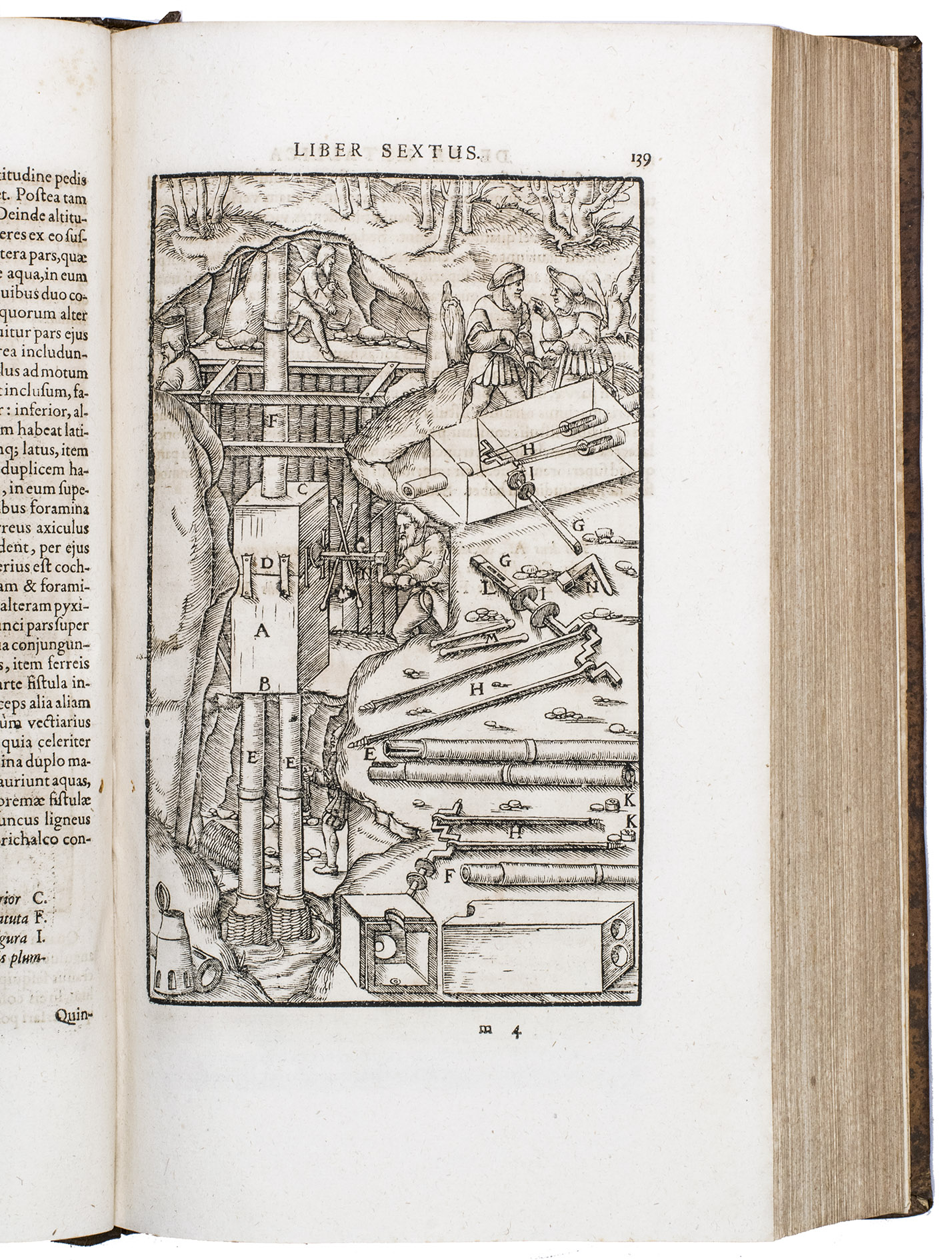AGRICOLA, Georgius.
De re metallica libri XII. Quibus officia, instrumenta, machinae, ac omnia denique ad metallicam spectantia, non modo luculentissime describuntur ... Quibus accesserunt hâc ultimâ editione, tractatus ejusdem argumenti, ab eodem conscripti, sequentes. De animantibus subterraneis ... De ortu & causis subterraneorum ... De natura eorum quae effluunt ex terra ... De natura fossilium ... De veteribus & novis metallis ... Bermannus sive de re metallica, dialogus ...
Basel, Emanuel König, 1657. Folio (ca. 34.5 x 20.5 cm). With a woodcut illustration on the title page (identical to the one printed on p. 176), 2 folding woodcut plates (one depicting a sundial) and 289 woodcut illustrations and diagrams in the text, including 68 almost full-page. Contemporary sprinkled calf. [1], [1 blank], [3], [3 blank], [8], 708, [58], [2 blank], [32] pp.
€ 6,850
Scarce fourth and final Latin edition of a fundamental work on mining and metallurgy by the German scholar Georgius Agricola (or Georg Bauer, 1494-1555), who is generally considered to be the founder of geology as a discipline. He supplied a new scientific classification of minerals based on their physical properties.
The De re metallica remained the most authoritative textbook on the subject for more than two centuries, paving the way for further systematic study of the earth and its rocks, minerals, fossils, refinery, and oil. It is lavishly illustrated with 290 striking woodcuts, including seven are monogrammed "RMD" in the block, generally attributed to the Swiss artist and printmaker Hans Rudolf Manuel Deutsch (1525-1571). These illustrations form a 16th-century graphic account of industrial activity in South Germany, depicting mining installations, utensils, and the different stages of the extraction and transformation of metals.
The first edition was published in 1556 in Basel by Hieronymus Froben (1501-1563) and his brother-in-law Nicolaus Episcopius (1501-1564). Subsequent editions appeared in 1561, 1621, and 1657, together with Agricolas treatise De animantibus subterraneis which was first published in 1549 (Basel, H. Froben and N. Episcopius). The present fourth edition is expanded with five smaller Latin works by Agricola, which were partly published between 1533-1546, forming together the first collective edition of almost all his technological writings on geology, metallurgy, mineralogy, palaeontology, and subterranean life. Our copy includes the often missing two preliminary text leaves comprising the dedication by the German theologian Cornelius Martinus (1568-1621) to the German physician and botanist Johannes Sigfridus (1556-1623), dated Helmstedt, 15 September 1612.
"The De Re Metallica embraces everything connected with the mining industry and metallurgical processes, including administration, prospecting, the duties of officials and companies and the manufacture of glass, sulphur and alum ... Some of the most important sections are those on mechanical engineering and the use of water-power, hauling, pumps, ventilation, blowing of furnaces, transport of ores, etc., showing a very elaborate technique" (PMM).
With a small leaf containing a short description of the work mounted at the foot of the front pastedown and traces of a book plate that was previously mounted on the front pastedown. The binding shows slight signs of wear, mainly around the spine with a small tear at its head and the corners of the boards are bumped, somewhat foxed and browned throughout. Otherwise in good condition. USTC 6139538; VD 17 3:309843V; cf. for the first ed. (1556) Brüning 1345; Caillet 79; Dibner 88; PMM 79; Rosenthal 8589; Sparrow, Milestones of science, no. 4; Wellcome I, 67-69.
Related Subjects:
























